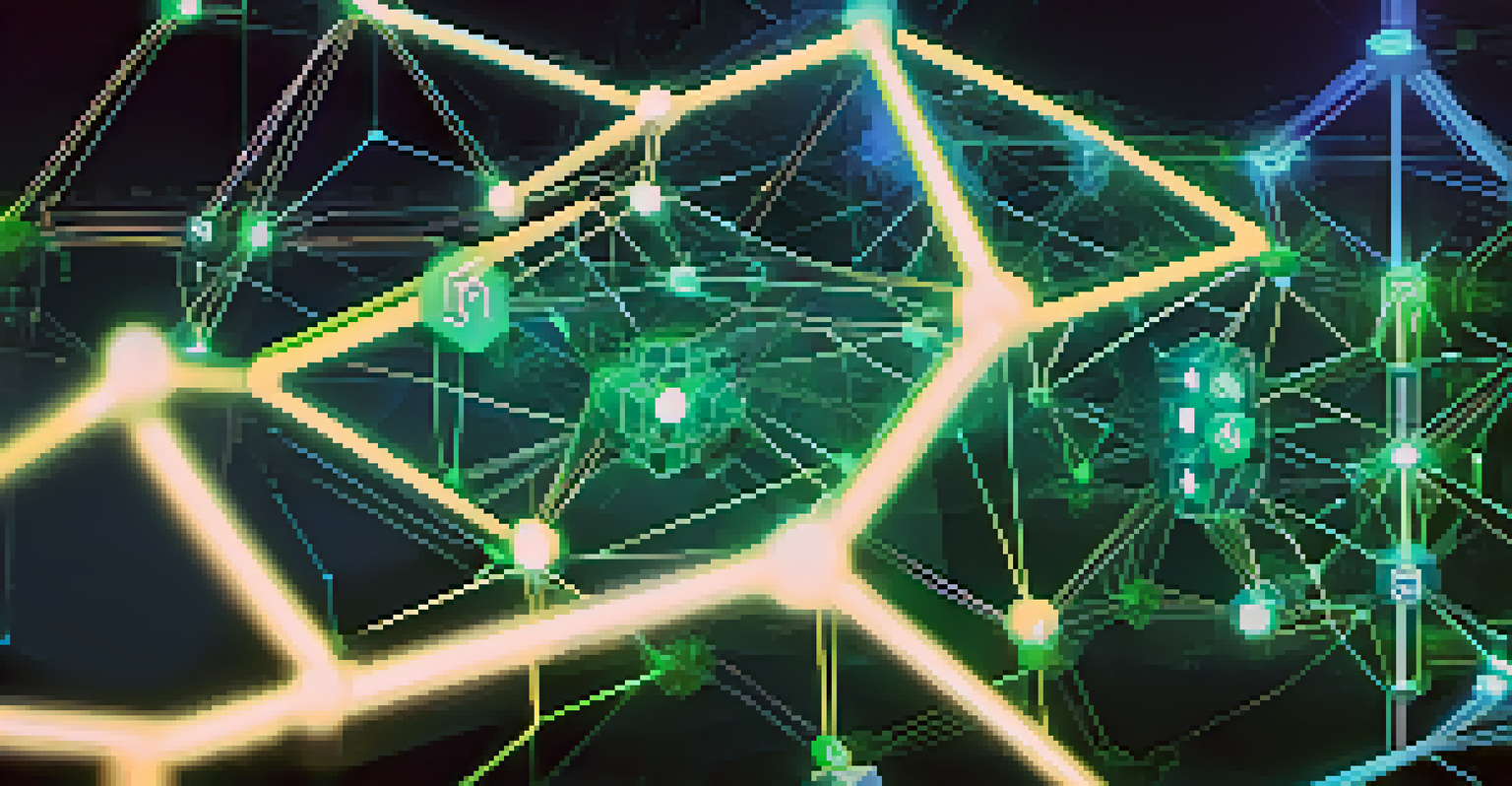The Role of Smart Contracts in NFT Digital Rights Management

What Are Smart Contracts and NFTs?
Smart contracts are self-executing agreements with the terms directly written into code. Think of them as digital vending machines: when you input a specific condition, they dispense the corresponding outcome automatically. Non-fungible tokens (NFTs), on the other hand, represent unique digital assets verified using blockchain technology, allowing for ownership of everything from art to music.
Smart contracts are the digital agreements that automatically execute and enforce themselves when the conditions are met, eliminating the need for intermediaries.
Together, smart contracts and NFTs create a powerful combination for digital rights management. They ensure that the ownership and transfer of digital assets are not only secure but also transparent. This relationship helps eliminate the middlemen typically involved in buying or selling digital content, streamlining the process significantly.
This synergy is crucial in today's digital landscape, where the value of creative work is often undermined by piracy and unauthorized use. By leveraging smart contracts in conjunction with NFTs, creators can protect their intellectual property and ensure they receive fair compensation for their work.
The Importance of Digital Rights Management
Digital rights management (DRM) refers to the legal and technical measures that protect creators' rights over their digital content. As the internet makes sharing easier, it also opens the door to unauthorized use, making effective DRM essential for artists and creators. Think of it as a digital lock that prevents others from using your work without permission.

In the context of NFTs, DRM becomes even more significant. By utilizing smart contracts, creators can embed specific rights and restrictions directly into the NFT, such as resale royalties or usage limitations. This ensures that any future transactions respect the creator’s original intentions and legal rights.
Smart Contracts Define Digital Rights
Smart contracts automate and enforce the rights related to NFTs, ensuring creators receive fair compensation and maintain control over their digital assets.
Moreover, having a robust digital rights management system helps bolster trust between creators and their audiences. When consumers know that their purchase supports the original artist, it fosters a greater appreciation for the work and encourages more ethical consumption of digital content.
How Smart Contracts Automate Rights Enforcement
One of the most powerful aspects of smart contracts is their ability to automate processes without the need for human intervention. When a transaction occurs, the smart contract executes predefined rules, automatically enforcing the rights embedded within the NFT. This is akin to a digital referee ensuring that all players follow the rules of the game.
The future of digital assets is about ownership, and NFTs are a key element in ensuring that creators retain control over their work.
For instance, if an artist sells an NFT with a 10% resale royalty, the smart contract will automatically deduct this percentage from any future sales, sending it directly to the artist. This not only ensures that creators receive ongoing compensation but also simplifies the entire sales process for everyone involved.
This automation also reduces the potential for disputes over rights and ownership. With everything coded into the smart contract, there’s less room for ambiguity, making it clear who owns what and under what conditions, which can save time and resources for all parties.
Creating and Minting NFTs with Smart Contracts
Minting an NFT involves creating a unique digital asset on the blockchain, and this process is facilitated by smart contracts. When an artist decides to mint their work, they use a smart contract to define the NFT's attributes, such as ownership, royalties, and other rights. Imagine this as crafting a personalized certificate of authenticity for a piece of art.
The smart contract acts as the backbone of the NFT, ensuring that all terms are adhered to throughout the asset's lifecycle. This means that every time the NFT changes hands, the smart contract automatically updates the ownership records and enforces any specified rights.
Digital Rights Management is Crucial
Effective digital rights management (DRM) is essential for protecting creators' rights in the digital landscape, particularly as it relates to NFTs and unauthorized use.
By simplifying the minting process, smart contracts empower more creators to enter the NFT space. This democratization of access encourages diversity and innovation in digital art, as artists from different backgrounds can share their unique works with the world.
Challenges and Limitations of Smart Contracts
While smart contracts offer numerous benefits, they also come with challenges and limitations. One significant issue is that once a smart contract is deployed on the blockchain, it’s typically immutable. This means that any mistakes or oversights in the contract cannot be easily corrected, which can lead to unintended consequences for creators and buyers alike.
Additionally, the coding required to create smart contracts can be complex, potentially leaving less tech-savvy creators at a disadvantage. If an artist doesn’t have the means to hire a developer or learn the intricacies of coding, they may struggle to leverage the full potential of NFTs and smart contracts.
Moreover, the legal landscape surrounding digital assets and smart contracts is still evolving. As regulators catch up with technology, creators must stay informed about changes that may impact their rights and responsibilities, making it crucial to approach the integration of smart contracts with caution.
Use Cases of Smart Contracts in NFT Rights Management
There are numerous practical applications of smart contracts in the realm of NFT digital rights management. For example, musicians can use smart contracts to ensure they receive royalties every time their song is streamed or resold as an NFT. This not only provides a steady income stream but also incentivizes artists to create and share more content.
Similarly, visual artists can embed specific rights into their NFTs, such as limiting how the artwork can be displayed or reproduced. This level of control allows artists to maintain their creative integrity while still benefiting from the sale and use of their works.
Challenges in Smart Contract Use
Despite their advantages, smart contracts present challenges such as immutability and complexity, which can hinder less tech-savvy creators from fully leveraging their potential.
Moreover, smart contracts can facilitate collaborations between creators. By outlining shared rights and revenue splits in a smart contract, multiple artists can work together seamlessly, knowing that their contributions are fairly compensated without the risk of misunderstandings.
The Future of Smart Contracts and NFTs
As the digital landscape continues to evolve, the role of smart contracts in NFT digital rights management is likely to expand. With ongoing advancements in blockchain technology, we may see even more sophisticated smart contracts that offer enhanced features and protections for creators. This could lead to a new era of digital ownership where artists have unprecedented control over their work.
Moreover, as awareness of NFTs and smart contracts grows, we can expect an influx of new creators entering the space. This democratization of digital art will likely lead to greater innovation and diversity in the types of content available, enriching the digital ecosystem as a whole.

Finally, as legal frameworks catch up with technology, the integration of smart contracts in digital rights management could become standardized. This would not only protect creators but also build consumer confidence in the NFT marketplace, paving the way for a more sustainable and ethical digital economy.